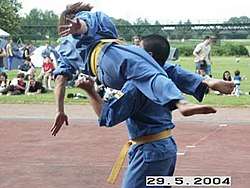Vietnamese martial arts

Flying scissors to the neck. The opponent is forced to the ground with a twist of the body.
| Part of a series on the |
| Culture of Vietnam |
|---|
.jpg) |
| History |
| People |
| Languages |
| Cuisine |
| Festivals |
| Literature |
|
Music and performing arts |
| Sport |
|
Monuments |
|
Symbols |
|
Traditional Vietnamese martial arts (Võ thuật Cổ Truyền Việt Nam) can be loosely divided into those of the Sino-Vietnamese descended from the Han, and the Chams or indigenous Vietnamese.
Modern schools
Modern styles, or Phái (schools), include:
- Võ thuật Bình Định/Bình Định Gia – umbrella title for all the traditional styles of Bình Định.
- Nhất Nam
- Vovinam – Founded by Nguyễn Lộc. Also called Vovinam Việt Võ Đạo (Việt = Vietnamese, Võ = martial, Đạo = way)
- Võ Việt Nam (Cuton) or Võ Đạo of Phạm Văn Tan.[1]
- Overseas
- Cuong Nhu of Ngô Đồng (d. Florida 2000), known also by the Japanese title O Sensei
- Tam Qui Khi-Kong, now popular in Russia
Terminology
- võ sư – master
- võ phục – tunic
- võ kinh – martial arts scripture
- Bắc Việt võ – Northern Vietnam style
- quyền – fist, such as Hùng kê quyền, Hồng Gia quyền, Lão mai quyền
- võ thuật Bình Định – martial arts of Bình Định
- Đấu vật – ring wrestling (can also mean western wrestling)
- Hand techniques (đòn tay)
- Elbow techniques (chỏ)
- Kicking techniques (đá)
- Knee techniques (gối)
- Forms (Quyền, Song Luyện, Đa Luyện)
- Attack techniques (chiến lược)
- Traditional wrestling (Vật cổ truyền)
- Leg Attack take-downs (đòn chân tấn công)
- Staff (côn)
- Sword (kiếm)
- Halberd (dao dài, "long knife")
- Rope dart/chain whip (nhuyễn tiên,different then chinese rope dart)
See also
References
- ↑ Gabrielle Habersetzer, Roland Habersetzer (2004). Encyclopédie des Arts Martiaux d'Extrême-Orient: Technique, historique, biographique et culturelle.
A la veille de l'indépendance du Vietnam (1955) différents groupements. sous le couvert d'associations sportives. virent le jour. avec notamment le mouvement Vovinam de Nguyen-Loc. le Tinh-Vô-Hoi (arts martiaux sino-vietnamiens) avec entre autres Chau Quan Ky. le Vo-Vietnam (Cuton) ou encore le Vu-Dao (Pham Van Tan*). Ces groupements connurent une structuration plus forte dans le cadre du Sud Vietnam dans les années 1960. avec. notamment. la création du Tong-Hoi-Vo-Hoc-Viet-Nam ..
This article is issued from
Wikipedia.
The text is licensed under Creative Commons - Attribution - Sharealike.
Additional terms may apply for the media files.